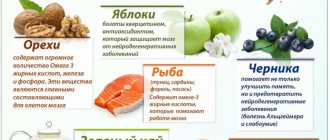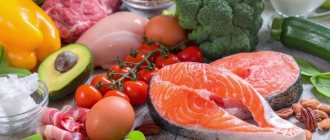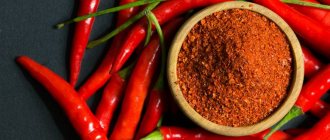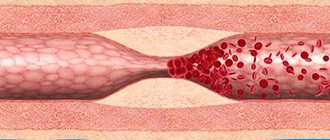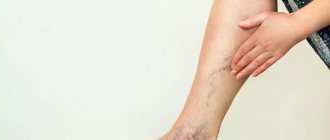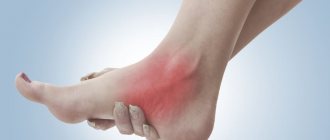The main factors that provoke the development of atherosclerotic changes in blood vessels are associated with an unhealthy lifestyle. Harmful gastronomic preferences, nicotine addiction, physical inactivity lead to a malfunction of lipid and protein metabolism in the body.
This provokes hypercholesterolemia (an increase in the amount of high molecular weight fatty alcohol - cholesterol) in the blood. Diet for atherosclerosis is one of the therapeutic methods for correcting cholesterol levels and is prescribed in parallel with medications.
Briefly about the development of atherosclerosis
An increase in total cholesterol levels is the result of dyslipidemia (impaired ratio of lipoproteins of different densities). After absorption of fats from the intestines into the blood, cholesterol, in correlation with proteins, forms low and high density lipoproteins (LDL - “bad” cholesterol and HDL - “good” cholesterol).
The former are responsible for the delivery of fats from the liver to the body tissues, the latter are responsible for the timely movement of excess “bad” cholesterol to the liver for disposal. With an excessive amount of low-density lipoproteins and the presence of damage on the inner layer of the vascular wall, part of the LDL “clings” to the injured area, forming a compaction (plaque).
As it increases, the vessel loses its elasticity and narrows, disrupting the natural blood supply to the organs. Atherosclerosis mainly affects:
- anterior, posterior and carotid arteries of the neck, supplying blood to the brain (cerebral atherosclerosis);
- vessels of the lower extremities;
- coronary arteries and thoracic aorta of the heart;
- renal vessels.
Cholesterol growths cause strokes, heart attacks, coronary heart disease, dry gangrene of the legs, and renal decompensation. Diet therapy helps prevent early complications and improve quality of life. A properly formulated diet allows you to minimize the intake of “bad” cholesterol and increase the amount of “good” high-density lipoproteins.
Reference! The average norm of total cholesterol for adults is 3.2-5.2 mmol/l. Hypercholesterolemia is considered to be > 6.7 mmol/l.
Reviews and results
This diet is designed to last for a long time, as it is balanced and contains a variety of foods. Some restriction in carbohydrates and fats does not adversely affect health, but on the contrary allows you to lose weight, normalize cholesterol and feel good. All these points are noted in the reviews of patients.
- “...I improved my health and lost weight. I liked this healthy diet. True, I was also prescribed pills to lower cholesterol”;
- “... I’m happy with the results: cholesterol has decreased, sugar has normalized, and I’ve even lost weight. Beauty!";
- “...Cholesterol was not very high, so I managed only with therapeutic nutrition. I continue to eat like this”;
- “... My result is minus 5 kg, my general condition has improved significantly and my tests have become normal”;
- “... Helped me lose weight and improve my condition, but I think that the tests became normal thanks to the pills. I won’t push myself further and will eat right.”
- “... This is not even a diet, but proper nutrition. I see only benefits in low-fat dishes without frying or batter. I eat constantly, even though no one prescribed it for me. Cholesterol is normal."
General Diet Information
Nutrition for atherosclerosis of the vessels of the brain, heart and legs is organized in accordance with the rules of the therapeutic diet “Table No. 10” (according to V. Pevzner’s classification). Correction of eating habits is aimed at reducing the level of low-density lipoproteins in the blood, cleansing the vascular system of cholesterol build-ups, and improving blood flow.
Hypercholesterolemia is not an indicator of obesity. Vessels clogged with cholesterol plaques are not uncommon for slender and even thin patients. Therefore, the nutritional system has two varieties, differing in calorie content and the amount of necessary nutrients.
Recommended standards
| Type of diet | Complex carbohydrates | Simple carbohydrates | Protein | Lipids (fats) | Drinking water | Daily caloric intake |
| For patients with normal BMI | up to 350 g | up to 50 g | 100 g, ratio of plant and animal proteins - 50×50 | 80 g, vegetable to animal – 40×60 | 1200-1500 ml | 2500 kcal |
| For patients with high BMI | 300 g | exclude | 80 g, ratio of plant and animal proteins - 50×50 | 70 g, vegetable to animal – 60×40 | 1200-1500 ml | 2000 kcal |
BMI – body mass index, calculated by the formula:
The normal value is BMI=25. Higher scores indicate overweight.
conclusions
Proper nutrition is an important aspect of treating atherosclerosis. Its principles are simple and painfully familiar to everyone: a minimum of fatty and sweet foods, more natural products. Still, the origins of the human race are lost somewhere in the lap of nature, and not behind the door of the nearest fast food restaurant.
Diet for atherosclerosis – both treatment and prevention. It is in the patient’s interests to make it primary (aimed at preventing the onset of symptoms of the disease) by studying healthy recipes.
Key rules of eating behavior
According to diet number 10, all foods are divided into three categories: prohibited, limited (restricted for consumption) and allowed. The distinction is primarily associated with foods rich in animal fats, from which “bad” cholesterol is formed.
General principles for organizing proper nutrition:
- eliminate prohibited products from the menu;
- introduce foods high in fiber, omega acids, polyphenols, and ascorbic acid into your diet;
- do not get carried away with products from the limited category;
- do not be greedy in food, that is, do not overeat;
- control the daily intake of calories, nutrients, drinking water;
- Avoid dishes prepared by frying (including frying in vegetable oil). Cooking food is allowed by boiling, stewing, steaming, baking under foil (brown crust on dishes is not welcome);
- reduce the consumption of salt and salty foods as much as possible;
- Follow the eating schedule - every 3-4 hours in small portions.
It is recommended to enrich the daily menu with restorative decoctions according to traditional medicine recipes.
No ads 1
List of dangerous products for atherosclerosis
In case of atherosclerosis of the cardiovascular system and arteries of the legs, foods and ready-made meals with large amounts of animal fats, salt, artificial fillers and stabilizers are prohibited. The prohibited list includes:
- fast food dishes (burgers, French fries, etc.);
- canned meat (pate, stew), canned fish, salted and pickled vegetables;
- preserves, salted and dried fish, caviar (any);
- smoked lard, meat, fish;
- sausages (boiled and smoked);
- mayonnaise and sauces made on its basis, mustard (all types), ready-made ketchup;
- ice cream, chocolate, condensed milk, desserts with butter cream, glazed curd cheeses;
- baking from puff pastry, yeast, shortbread and choux pastry;
- chips and any flavored snacks;
- semi-finished minced meat;
- offal and meat of duck, goose, pig.
The listed fatty meats are also not suitable as a soup base (broth). Until recently, eggs were considered dangerous for hypercholesterolemia, but recent studies have rehabilitated the product. Today, patients with atherosclerosis are allowed to eat 1-2 chicken eggs per week (or 5-10 quail eggs).
In terms of energy value and weight, 1 chicken egg is equal to five quail eggs
Fully or partially limited products
Products made from puff pastry and butter dough, meat, fish, and mushroom broths are completely excluded. You cannot eat fatty pork, cooking fats, duck, goose, kidneys, brains, liver, sausages, canned food and all kinds of smoked meats.
Fatty fish, canned fish and caviar, salted and smoked fish are prohibited. Do not eat fatty cheese and cream, cottage cheese and sour cream. The consumption of radishes, radishes, sorrel, spinach and mushrooms is prohibited. Chocolate, ice cream, and products with cream are not allowed. As for sauces, you should not use meat, fish, mushroom, or mustard. Strong tea and coffee, cocoa are prohibited.
Limit egg yolks, rice, semolina and pasta, mayonnaise, horseradish. For obesity - grapes, sugar, honey, raisins, jam are allowed rarely and in minimal quantities.
Table of prohibited products
| Proteins, g | Fats, g | Carbohydrates, g | Calories, kcal | |
Vegetables and greens | ||||
| radish | 1,2 | 0,1 | 3,4 | 19 |
| white radish | 1,4 | 0,0 | 4,1 | 21 |
| red radish | 1,2 | 0,1 | 3,4 | 20 |
| black radish | 1,9 | 0,2 | 6,7 | 35 |
| spinach | 2,9 | 0,3 | 2,0 | 22 |
| sorrel | 1,5 | 0,3 | 2,9 | 19 |
Fruits | ||||
| bananas | 1,5 | 0,2 | 21,8 | 95 |
Berries | ||||
| grape | 0,6 | 0,2 | 16,8 | 65 |
Mushrooms | ||||
| mushrooms | 3,5 | 2,0 | 2,5 | 30 |
Nuts and dried fruits | ||||
| raisin | 2,9 | 0,6 | 66,0 | 264 |
Cereals and porridges | ||||
| semolina | 10,3 | 1,0 | 73,3 | 328 |
| rice | 6,7 | 0,7 | 78,9 | 344 |
Flour and pasta | ||||
| pasta | 10,4 | 1,1 | 69,7 | 337 |
Confectionery | ||||
| jam | 0,3 | 0,2 | 63,0 | 263 |
| jam | 0,3 | 0,1 | 56,0 | 238 |
| candies | 4,3 | 19,8 | 67,5 | 453 |
| pastry cream | 0,2 | 26,0 | 16,5 | 300 |
| cookie | 7,5 | 11,8 | 74,9 | 417 |
Ice cream | ||||
| ice cream | 3,7 | 6,9 | 22,1 | 189 |
Cakes | ||||
| cake | 4,4 | 23,4 | 45,2 | 407 |
Chocolate | ||||
| chocolate | 5,4 | 35,3 | 56,5 | 544 |
Raw materials and seasonings | ||||
| mustard | 5,7 | 6,4 | 22,0 | 162 |
| mayonnaise | 2,4 | 67,0 | 3,9 | 627 |
Dairy | ||||
| milk 3.6% | 2,8 | 3,6 | 4,7 | 62 |
| milk 4.5% | 3,1 | 4,5 | 4,7 | 72 |
| cream | 2,8 | 20,0 | 3,7 | 205 |
| sour cream 25% (classic) | 2,6 | 25,0 | 2,5 | 248 |
Cheeses and cottage cheese | ||||
| cheese | 24,1 | 29,5 | 0,3 | 363 |
| cottage cheese 11% | 16,0 | 11,0 | 1,0 | 170 |
| cottage cheese 18% (fat) | 14,0 | 18,0 | 2,8 | 232 |
Meat products | ||||
| pork | 16,0 | 21,6 | 0,0 | 259 |
| pork liver | 18,8 | 3,6 | 0,0 | 108 |
| pork kidneys | 13,0 | 3,1 | 0,0 | 80 |
| pork fat | 1,4 | 92,8 | 0,0 | 841 |
| salo | 2,4 | 89,0 | 0,0 | 797 |
| beef liver | 17,4 | 3,1 | 0,0 | 98 |
| beef kidneys | 12,5 | 1,8 | 0,0 | 66 |
| beef brains | 9,5 | 9,5 | 0,0 | 124 |
Sausages | ||||
| smoked sausage | 16,2 | 44,6 | 0,0 | 466 |
| smoked sausage | 9,9 | 63,2 | 0,3 | 608 |
| sausages | 10,1 | 31,6 | 1,9 | 332 |
| sausages | 12,3 | 25,3 | 0,0 | 277 |
Bird | ||||
| smoked chicken | 27,5 | 8,2 | 0,0 | 184 |
| duck | 16,5 | 61,2 | 0,0 | 346 |
| smoked duck | 19,0 | 28,4 | 0,0 | 337 |
| goose | 16,1 | 33,3 | 0,0 | 364 |
Fish and seafood | ||||
| smoked fish | 26,8 | 9,9 | 0,0 | 196 |
| salted fish | 19,2 | 2,0 | 0,0 | 190 |
| Red caviar | 32,0 | 15,0 | 0,0 | 263 |
| black caviar | 28,0 | 9,7 | 0,0 | 203 |
| canned fish | 17,5 | 2,0 | 0,0 | 88 |
| cod (liver in oil) | 4,2 | 65,7 | 1,2 | 613 |
Oils and fats | ||||
| animal fat | 0,0 | 99,7 | 0,0 | 897 |
| cooking fat | 0,0 | 99,7 | 0,0 | 897 |
Non-alcoholic drinks | ||||
| instant coffee dry | 15,0 | 3,5 | 0,0 | 94 |
| black tea | 20,0 | 5,1 | 6,9 | 152 |
| * data is per 100 g of product | ||||
Limited product category
Cholesterol is necessary for the body for the full production of sex hormones, adrenal hormones, for the synthesis of vitamin D, as a building material and for the protection of cell membranes. Diet rules allow limited consumption of animal fats, in particular, you are allowed to eat 10-15 g of butter (per day).
Vegetable oils that do not contain cholesterol should be limited to people with excess body weight, as a source of additional calories. When choosing vegetable oil, preference should be given to products with a high content of Omega acids (olive, flaxseed, grape seed and milk thistle oils).
A rich source of Omega is fatty fish (sturgeon, halibut, capelin, mackerel). Their use is allowed once a week. In case of atherosclerosis accompanied by obesity, it is necessary to limit the consumption of pasta. They must be made from the highest varieties of wheat, devoid of gluten (category “A”).
The category of simple carbohydrates allowed for a normal BMI includes marmalade, dried fruits, and marshmallows. Soy sauce is allowed in the diet, however, it should not be abused due to the high salt content in the product.
The ban on pork consumption does not apply to lard, which contains arachidonic acid, a substance that increases high-density lipoprotein levels. Patients are allowed 10 g of lightly salted lard per day.
Important! The consumption of boiled and fried lard is strictly prohibited.
No ads 2
Varieties
There are two dietary options.
The first option for non- obese : protein content - 90-100 g (half of them of animal origin), fats - 80 g (half of vegetable origin), carbohydrates - 350-400 g (50 g of sugar per day in all dishes). The calorie content of this food option is 2600-2700 kcal.
The second option is prescribed for concomitant obesity and is characterized by a reduced amount of fat (up to 70 g per day), carbohydrates (300 g) and calorie content (2200 kcal).
Authorized and recommended products
In dietary nutrition for atherosclerosis of the vessels of the lower extremities, coronal and cerebral vessels, the emphasis is on eating foods rich in fiber, vitamins, and antioxidants. Protein products allowed for atherosclerosis are lean varieties of meat, fish, and poultry. They are easily digestible and do not affect cholesterol levels.
The menu must include dairy and fermented milk products, but with a low fat content:
Flaxseed oil for high cholesterol
- kefir, fermented baked milk, natural (without additives) yogurt – 2.5%;
- acidophilus – 3.2%;
- cottage cheese – 1.8-5%;
- Adyghe cheese, tofu, ricotta – up to 18%;
- sour cream and cream - no more than 10%.
A good addition to dishes would be rye and wheat bran, which acts on the intestines as a natural adsorbent. Bran actively removes bile acids, which promote the absorption of “bad” cholesterol. Cereals and grain crops work in a similar way, so patients with atherosclerosis must eat porridge and other cereal dishes. Preference should be given to buckwheat, rice, and pearl barley.
Vegetables, herbs, berries and fruits are not subject to varietal differentiation. You can eat anything, depending on your taste preferences. The most effective for lowering cholesterol levels are celery, cabbage of all varieties, tomatoes, lemons, pomelo, ginger, cranberries and lingonberries.
It is recommended to specifically include in the treatment menu products containing:
- lutein (spinach, green peas);
- carotenoids (carrots, sea buckthorn);
- folic acid (beans, lettuce, pomegranate);
- phytosterols (rice bran, corn);
- polyphenols (sage, green tea, blueberries and black currants).
Allowed sources of protein include: turkey, chicken (skinless), veal, navaga, telapia, blue whiting, pollock, seafood.
Garlic is considered one of the effective remedies against deposits of “bad” cholesterol in blood vessels. For atherosclerosis, garlic use is recommended daily
About drinks
In order not to create additional stress on the blood vessels of the brain and heart, you should stop drinking coffee. Sweet soda should be completely excluded from the diet. Healthy drinks include:
- compote of fresh or frozen berries;
- fruit compote or jelly (no added sugar);
- green tea with mint;
- fresh vegetable;
- decoction of rosehip, burdock and dandelion roots;
- ginger-citrus drink.
Advice! To prepare a ginger-citrus drink, you need to cut 1 orange and 1 lemon, brew with boiling water, leave for a quarter of an hour, add grated ginger root. You can drink at any time of the day. The drink has a powerful antioxidant effect, helps lower cholesterol, strengthens the immune system, and promotes weight loss.
[node:field_similarlink]
About alcohol and high cholesterol
Small doses of ethyl alcohol, as a chemical compound, can increase the level of “good” cholesterol. However, exceeding the alcohol limit forces the liver to direct all its efforts to quickly neutralize toxins and eliminate acetaldehyde, so the production of HDL stops. At the same time, the level of low-density lipoproteins does not change, due to which the total cholesterol level increases.
Additional negative factors are the destructive effect of ethanol on the walls of blood vessels (a cholesterol plaque forms at the site of microtrauma), clouding of consciousness provokes the consumption of foods from the prohibited list, disruption of the rhythmic functioning of the heart (with aortic atherosclerosis, it threatens a heart attack).
Ideally, patients with atherosclerosis should stop drinking alcohol. A single dose of strong alcohol is allowed for men not more than 100 ml, for women - 50 ml.
Table No. 10 and examples of dietary dishes for atherosclerosis
When creating a menu, you must use only the components of the permitted food basket, follow the rules for eating and cooking food. For ease of use of the diet, the diet is developed for a week. Breakfast options:
- omelet cooked in the microwave with the addition of herbs, tomatoes, low-fat cheese;
- porridge cooked on a milk or water basis from oatmeal, wheat or rice;
- cheesecakes baked in the oven;
- lazy dumplings with cottage cheese.
Fresh fruit, fruit puree, berry mousse, oven-baked apples, fruit cocktail or salad are suitable for lunch (second breakfast). You can supplement your snack with biscuits and unsweetened cookies. Lunch should include two courses. You can combine products to suit your taste.
Salads:
- vegetable (tomatoes + herbs + cucumbers + vegetable oil);
- vitamin (white or Chinese cabbage + carrots + olive oil);
- the vinaigrette;
- beetroot (boiled beets + garlic + walnuts + sour cream 10% fat);
- carrots in Korean.
No ads 3
First meal:
- chicken soup with vermicelli (homemade noodles);
- bean soup with chicken broth;
- vegetarian cabbage soup;
- cold borscht or gazpacho;
- fish soup with pearl barley.
Important! Sautéing vegetables to season soup is prohibited. The broth is made from low-fat fish. Before preparing chicken broth, you must first remove the skin from the bird.
For an afternoon snack, we offer cottage cheese casserole with apples, fresh cottage cheese with natural yoghurt and berries, ready-made grain cottage cheese with rye bread, and fermented baked milk with unsweetened cookies. It will be useful to add a tablespoon of bran to cottage cheese or fermented baked milk. Dishes for evening meals:
- pilaf with chicken breast;
- boiled fish with mashed potatoes;
- steamed turkey cutlets with crumbly pearl barley or buckwheat;
- vegetable stew;
- steamed fish cutlets with boiled rice;
- chicken meatballs steamed with boiled cauliflower or broccoli;
- potato casserole with tofu cheese.
All dishes must be supplemented with fresh vegetables, sauerkraut (limited), canned peas, ready-made seaweed salad, and fresh herbs. These foods will help bind and eliminate cholesterol. To improve digestion and prevent evening hunger, it is recommended to drink a glass of low-fat fermented milk drink (kefir, acidophilus) two hours before bedtime.
Results
Atherosclerosis is a dangerous disease of the body’s vascular system, characterized by the deposition of “bad” cholesterol on the intima (inner layer of blood vessels). At the same time, the level of “good” cholesterol is significantly reduced.
The compaction and proliferation of cholesterol plaques leads to blockage of the lumen of the arteries, causing coronary heart disease, cerebrovascular accident with the risk of stroke, and gangrenous lesions of the lower extremities. A proper diet helps lower cholesterol levels and maintain their stability.
A diet developed on the basis of the “Table 10” diet should contain a maximum of fresh vegetables, berries and fruits, cereals and protein dishes, and healthy drinks. Therapy of atherosclerosis is a long process. It is important to strictly follow nutritional rules not only during treatment, but also for prevention (after cholesterol levels decrease).
Advantages and disadvantages
| pros | Minuses |
|
|
